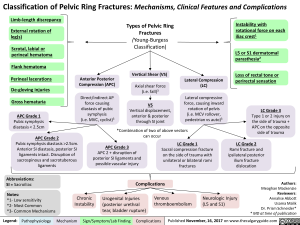Classification of Pelvic Ring Fractures: Mechanisms, Clinical Features and Complications
Limb-length discrepancy >2.5cm. SI of Types of Pelvic Fractures (Young-Burgess Classification) Ring • Instability with External rotation of rotational force on each leg(s) iliac crest’ • vectors LC Scrotal, labial or 15 or S1 dermatomal perinea! hematoma parasthesia2 Flank hematoma Vertical Shear (VS) Axial shear force (i.e. fall)3 Loss of rectal tone or Perinea! lacerations Anterior Posterior Compression (APC) Lateral Compression (LC) perirectal sensation De-gloving injuries Direct/indirect AP force causing diastasis of pubic symphysis (i.e. MVC, cyclist)3 *Combination APC Grade Lateral compressive force, causing inward rotation of pelvis (i.e. MCV rollover, pedestrian vs auto)3 Grade 1 Rami ipsilateral LC Grade • Gross hematuria VS Vertical displacement, anterior & posterior through SI joint APC Grade 1 LC Grade 3 Type 1 or 2 injury on the side of trauma + APC on the opposite side of trauma Pubic symphysis diastasis < 2.5cm APC Grade 2 of two can 3 of above occur Sacral on the unilateral 2 Pubic symphysis diastasis Anterior SI diastasis, posterior ligaments intact. Disruption sacrospinous and sacrotuberous ligaments compression fracture side of trauma with or bilateral rami fractures fracture and posterior ilium fracture dislocation APC 2 + disruption of posterior SI ligaments and possible vascular injury
Abbreviations: SI = Sacroiliac Notes: *1- Low sensitivity *2- Most Common *3- Common Mechanisms Authors: Meaghan Mackenzie Reviewers: Annalise Abbott Usama Malik Dr. Prism Schneider* * MD at time of publication Complications Chronic Instability Urogenital Injuries (posterior urethral tear, bladder rupture) NW. Venous thromboembolism Neurologic Injury (L5 and S1)
Foundations
Systems
Other Languages
Orthopedics Trauma Classification of Pelvic Ring Fractures: Mechanisms, Clinical Features and Complications Classification of Pelvic Ring Fractures: Mechanisms, Clinical Features and Complications

